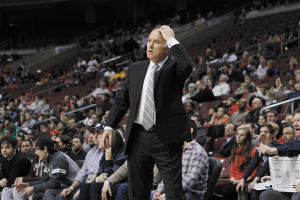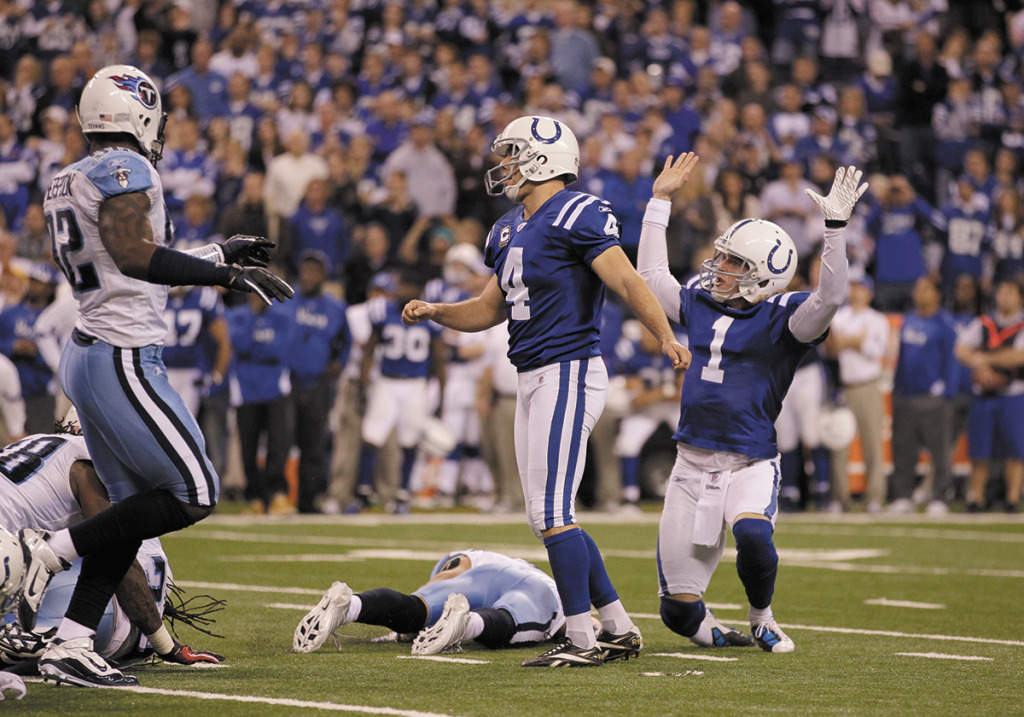Subscriber Benefit
As a subscriber you can listen to articles at work, in the car, or while you work out. Subscribe Now Jan. 1 begins a new year, a good thing considering how the old one went. It also begins a new decade, because 2020 wasn’t the start of a decade any more than our calendar began with year Zero—or, for that matter, an athlete has played in two seasons when he’s a rookie.
Jan. 1 begins a new year, a good thing considering how the old one went. It also begins a new decade, because 2020 wasn’t the start of a decade any more than our calendar began with year Zero—or, for that matter, an athlete has played in two seasons when he’s a rookie.
It’s a natural time to look ahead, not only for one year but for 10. Trouble is, a 10-year swath of time is an epoch or two in the sports world, where the career of a player, the fate of a team and the mood of a city can change in the blink of a torn ACL or trade demand. You might as well give a 10-year weather forecast as predict what any team or athlete will experience over the next decade.
To comprehend all that can change, for better and for worse, you need only go back a decade and see where our local sports teams stood on New Year’s Day in 2011. Nobody then could have come close to guessing what was in store for them. The decade ahead promises to be equally dramatic and unpredictable.
The lesson to be learned: It’s difficult and time-consuming to achieve a high level of success in any business, and getting there should never be taken for granted or assumed to be sustainable.
◗ Butler University, for example, had just defeated Valparaiso, 76-59, when 2011 began. It marked the 23rd consecutive Horizon League victory for the Bulldogs and the 99th career win for Brad Stevens, who was in his third season as head coach.
Imagine telling someone then where the program was headed.
The Bulldogs were coming off a season in which they had shocked the nation by reaching the championship game of the NCAA tournament, missing out on a dramatic moment of fictional proportions by the mere couple of inches that Gordon Hayward’s half-court heave went awry at the final buzzer. Surely nothing like that could happen again.
But it did, sort of. Although Hayward had left for the NBA, the Bulldogs were back playing for the championship in 2011, this time losing to Connecticut. But when you reach the mountaintop, the only available direction is downward.
Stevens, who began his professional working career at Eli Lilly and Co., stayed two more seasons, then took the Boston Celtics’ coaching offer in 2013. Butler has had three coaches since then, including the current one, LaVall Jordan. It also would play in two more conferences, the Atlantic 10 and now the Big East.
Butler in the Big East? Stevens coaching the Celtics? Impossible, 10 years ago.
◗ The Indianapolis Colts were one day short of completing their regular season on Jan. 1, 2011, and did so with a flourish.
Adam Vinatieri’s 43-yard field goal as the final seconds ticked off the clock provided a 23-20 victory over Tennessee before 67,188 fans at Lucas Oil Stadium. That completed their regular season with a 10-6 record and brought a seventh AFC South title in their previous eight seasons and a ninth straight playoff appearance.
They were the picture of stability. Or so it appeared. Quarterback Peyton Manning was one season removed from winning his fourth league Most Valuable Player award and leading the Colts to the Super Bowl against the New Orleans Saints. At 34, he appeared to have at least a few good years left. Team President Bill Polian, who built two Super Bowl teams, remained in the front office and Coach Jim Caldwell had guided the team to the second of those championship opportunities in his first season.
All the pieces were in place for continued runs.
If only.
The Colts locked up Manning for another season with the franchise tag in February. He had to undergo neck surgery in May, however, then was ruled out for the season after a second surgery in September. They plunged to 2-14 as Kerry Collins and Curtis Painter filled in at quarterback, but that brought the silver lining of the No. 1 pick in the NFL draft. And lo and behold, waiting in the wings was Stanford All-American quarterback Andrew Luck, far more athletic than Manning and just as smart.
Suddenly past his prime and disposable, Manning was waived in March 2012, a harsh ending to a Colts career that already had made him a lock for the Pro Football Hall of Fame. He signed with Denver and played four more seasons, leading the Broncos to a Super Bowl victory in the final one. Just as everyone would have predicted at the start of the decade, of course.
The Colts? Luck was a sensation at first, setting league rookie passing records and earning Pro Bowl honors his first three seasons, but an inadequate offensive line and his reckless playing style took their toll. He played in just seven games in 2015 and none in 2017. He was voted Comeback Player of the Year and into the Pro Bowl again after playing all 16 games in 2018, but abruptly retired on Aug. 24, 2019.
During Luck’s seven-year career, Chuck Pagano was transformed from beloved rookie head coach who survived cancer and led a team to the playoffs to one who had worn out his welcome with the fan base by the time his last team finished 4-12 in 2017.
The Colts finished the decade with a third Hall-of-Fame-caliber quarterback, Phillip Rivers, barking signals. He’s still going strong at 39 years old, the same age at which Manning retired, and to the surprise of many, is playing on a Manning-like level.
Nobody could have called that one on New Year’s Day 10 years ago. Or two years ago, for that matter.

◗ The Indiana Pacers were stumbling along with a 14-17 record when 2010 concluded. And then things got worse.
They lost nine of their first 11 games in 2011, a dismal occurrence that led to the dismissal of Coach Jim O’Brien. Assistant Frank Vogel, unknown to the general fan base and considered by many nothing more than an interim replacement, brought an immediate turnaround with his upbeat nature and more fundamental approach.
He inherited a solid group of players that included promising rookie Paul George, who averaged just 7.8 points but displayed a rare combination of strength and athleticism.
Vogel’s revitalized Pacers won seven of their next eight games, managed a winning record through the remainder of the regular season and qualified for the playoffs for the first time in five years. Vogel went on to lead them to the 2013 conference finals, where they lost to Miami in seven games.
That team had a lot of somethings going for it. George was 22 years old and coming off his first all-star season. Lance Stephenson, also 22, had established himself as a starter with a promising future. George Hill, 27, was a heady point guard and strong defender who averaged 14 points. David West, the veteran at 32, was a former all-star and a highly regarded leader on and off the court who averaged 17 points and 8 rebounds. Roy Hibbert, 26, had played in the all-star game the previous season and averaged 22 points and 10 rebounds in the 2013 conference finals.
Thirty-year-old Danny Granger, a former all-star, was scheduled to rejoin that group after recovering from a knee injury the following season, creating what seemed an embarrassment of riches. They backed it up by beginning the following season 16-1 and attracting national media coverage as a serious title contender. But while they reached the conference finals again in the 2013-2014 season, the core was beginning to unravel like a cheap Christmas stocking.
Granger never truly recovered and was traded during the season. Hibbert became frustrated by a diminished role in the offense and began faltering emotionally. Stephenson, a free agent, declined an offer from the Pacers that was as large as it could be without exceeding the luxury tax threshold, held out and wound up taking a lesser deal from Charlotte. George, seemingly destined to become one of the franchise’s all-time greats, broke his leg in an Olympic trials game in 2014 and missed all but the final six games of the next season. West, unwilling to participate in a rebuild at an advanced age, took a major pay cut to play in San Antonio in 2015. Hibbert, having fallen out of favor with the fan base and front office and out of style as a low-post player, was traded to the Lakers for a second-round draft pick in what amounted to a salary dump that same summer. George Hill left as a free agent in 2016.
Vogel left that summer as well when his contract was allowed to expire. One year later, George issued his infamous trade demand. Three years after a run to the conference finals, the starting lineup and head coach all were gone.
George is the only player from the Pacers team that began 2011 who is still playing in the NBA. He’s now with the Clippers, his third team of the decade, still highly regarded but less beloved than in his early days as a Pacer. Vogel, meanwhile, was fired after coaching undermanned teams in Orlando and directed the Lakers to the championship last season.
Nate Bjorkgren, who began the previous decade as an assistant coach for the Iowa Energy of the NBA’s Development League, begins this one as the Pacers’ head coach. Like Vogel a decade ago, he’s a young, upbeat and energetic coach eager to get going. And like Vogel a decade ago, nobody can possibly predict where he might be going.
◗ The Indiana Fever were riding high when 2011 arrived. They had compiled winning records in five of their previous six seasons and a .500 record in the other one. They followed by going 21-13 in 2011, a record they must have really liked because it was the fifth time in the previous seven years they finished with it.
They continued their momentum into 2012, when they clinched the WNBA championship at Bankers Life Fieldhouse. They were back in the finals in 2015 but lost to Minnesota, then went 17-17 the following season, the last for franchise icon Tamika Catchings.
They have struggled mightily since then, going 34-90 over the last four seasons with no playoff appearances. They have fallen a long way from championship contention, or even respectability. But as the other local teams have proved, things can change quickly.
They are on their fourth head coach since 2011 began. So is Butler. So are the Pacers. And so are the Colts if you include Bruce Arians’ 9-3 stint as Pagano’s replacement in 2012.
Four local teams. Fifteen head coaches and an interim. One championship and a few near-misses. Playoffs made, playoffs missed. Endless mood swings.
Brace yourselves. The next decade should bring more of the same.•
__________
Indianapolis native Mark Montieth is a longtime newspaper reporter and freelance writer. He is the author of three books: “Passion Play: Coach Gene Keady and the Purdue Boilermakers,” “Reborn: The Pacers and the Return of Pro Basketball to Indianapolis,” and “Extra Innings: My Life in Baseball” with former Indianapolis Indians president Max Schumacher.
Please enable JavaScript to view this content.


Nice article Mark. A good walk down memory lane